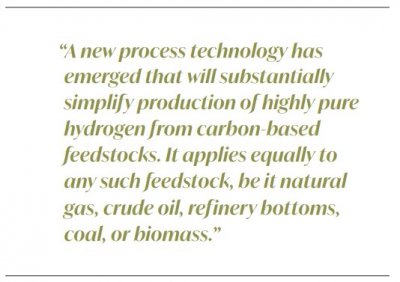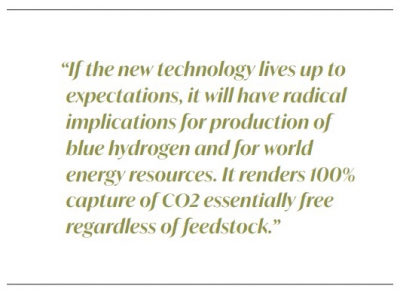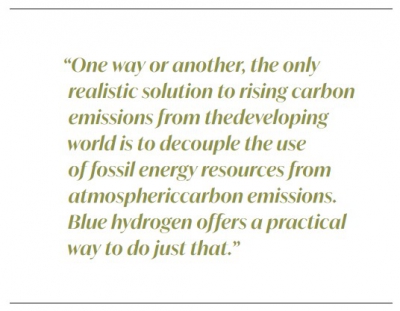Natural gas versus coal for blue hydrogen [Gas in Transition]
Natural gas has a reputation for being cleaner and easier on the environment than coal. It very likely is – although “easier on the environment than coal” is not saying much. All the same, burning natural gas for power generation does emit only half the CO2/kWh as burning coal. Data from the World Bank indicates that the per-capita carbon emissions in the US have dropped by about 35% since 1973. A large factor in that drop has been a switch from coal to natural gas for much of our power generation. Gas wells and the pipelines required to capture and process gas well output are also less disruptive to the environment than the open pit mining operations used to access cheap low-sulphur coal in the western US – not to mention the mountain top removal methods used to access hard coal in the Appalachian mountains of the eastern US. So yes, natural gas is more environmentally friendly than coal.
Unfortunately, merely reducing per-capita carbon emissions will do nothing to mitigate the growing havoc wreaked by global warming, rising sea levels, and an increasingly chaotic climate. At best, it will slow the rate at which things deteriorate. It might lessen the degree of overshoot and shorten recovery time, if and when we manage to achieve net zero and then go on to net negative CO2 emissions. But we’ve already crossed into serious overshoot. Years ago, NASA climate scientist Jim Hanson calculated that 350 parts per million (ppm) would be the maximum level of atmospheric CO2 that would allow for a “safe” level of long term global warming. We’ve long since blown past that benchmark. “Climate inertia” has so far delayed the worst of the consequences, but that may now be changing. We really need to reach net zero as soon as possible. Every year we don’t just increases the cost we and our descendents will be paying.
Pathways to net zero
There are three pathways to net zero carbon emissions. The first is switching to energy resources that inherently don’t emit carbon, such as wind, solar, and nuclear. The second is to capture and sequester the carbon emissions from energy resources that do emit carbon. The third is to implement systems that capture carbon directly from the atmosphere and sequester it. The three pathways are by no means mutually exclusive. Each has particular advantages and disadvantages. We will need to employ all three. Also, bearing on all three is the need for energy efficiency. We need to limit our energy consumption as much as reasonably possible. Though we can’t count on efficiency alone to achieve net zero, it will help to hasten our journey along the other pathways.
Note that I did not list “hydrogen” as a pathway to net zero carbon emissions. Hydrogen will play a role, but it is not itself a source of energy. If the hydrogen is electrolytic and used for energy storage, then the low 40% round-trip efficiency typical of “power to hydrogen to power” (P2H2P) means that 2.5 kWh of energy from some other zero-carbon energy resource will be needed for every kWh of electricity generated from hydrogen. Production of electrolytic hydrogen will result in a major increase in global energy consumption. If the electricity producing the hydrogen is not zero-carbon, the use of hydrogen for electricity production might be counterproductive. It could end up increasing global carbon emissions rather than reducing them.
One way around electrolytic hydrogen’s problem of increased power demand is so-called “blue” hydrogen. That’s hydrogen produced by steam reforming of carbon-based fuels. The reforming process produces substantial amounts of CO2, but if the CO2 is captured and sequestered, what one is left with is carbon-free hydrogen. The energy content of the hydrogen will be less than that of the carbon-based fuel from which it was made; the energy efficiency of the reforming process is never 100%. But 80% is feasible. A new one-step process under development and testing in Norway could make 90% commercially feasible. More on that in a moment.
The attraction of blue hydrogen is the high ratio of hydrogen production capacity to capital invested. Even with carbon capture factored in, the chemical plant needed to produce X tons of hydrogen daily by reforming can be substantially less expensive than the corresponding electrolysis plant and the generation capacity to power it. The theoretical minimum energy cost for hydrogen by electrolysis at ambient temperature is 39 kWh/kg; the practical minimum is more like 50 kWh. For blue hydrogen, the external energy cost is an order of magnitude lower. The carbon-based fuel being reformed supplies nearly all the chemical energy required.
The downside for blue hydrogen is of course the cost of the carbon-based fuel being reformed. If the fuel is cheap and available, then blue hydrogen will beat green hydrogen by a wide margin in terms of monetary cost/kg. If carbon capture is complete, blue hydrogen will also beat green in terms of life cycle carbon emissions. The inherently high materials and energy costs of building the wind, solar, and energy storage capacities are the problem. The capacities required to power an electrolysis plant mean that the plant incurs a large carbon debt before it becomes operational. However, if the carbon-based fuel for production of blue hydrogen is unavailable or very expensive – as natural gas is currently in the EU – then green hydrogen will be cheaper.
Or, rather, it would be cheaper, if the power grid had already been decarbonised and there was sufficient zero-carbon energy capacity available to power the electrolysis plants. It would also be necessary that no economical alternative to abnormally expensive natural gas happened to be available. But that’s not the case. Coal is a viable alternative to natural gas for production of hydrogen. It is definitely available in most parts of the world, and very economical in terms of thermal energy content. It’s admittedly harder to work with than natural gas, but not prohibitively so. China and other Asian nations with limited access to natural gas have built their chemical and fertiliser industries around hydrogen produced from coal. They don’t employ CCS, and they don’t employ the newest and most efficient reforming technologies that are becoming available. But they certainly demonstrate that production of hydrogen from coal can be viable.
Hydrogen from coal?
Those knowledgeable of chemical engineering may rightly object that it’s mostly not hydrogen that China and other countries are producing from coal. Rather, it’s syngas. Syngas is a mix of hydrogen (H2) and carbon monoxide (CO). It serves as the starting point for synthesis of a wide range of organic chemicals and plastics. Syngas can be processed to yield pure H2, but there’s a cost. It normally takes several additional steps that add complexity and energy cost to the overall process train. The key step is the water gas shift reaction (WGSR):
CO + H2O ⇌ CO2 + H2 + heat
The ‘⇌’ symbol indicates an equilibrium reaction. The forward and reverse reactions run in parallel. The reactants settle toward equilibrium concentrations that depend on the temperature and pressure in the reactor, along with the relative concentrations of reactants in the feed stream. The ‘+ heat’ in the reaction equation indicates that the forward reaction is exothermic. It produces heat. That implies that the desired forward reaction is favoured by lower reactor temperatures. That’s unfortunate, as heat produced at lower temperatures can be hard to utilise elsewhere in the overall process. It has to be dissipated, at a loss in net process efficiency. Also, the outfeed from the WGSR won’t be pure hydrogen, or even a simple mix of CO2 and H2. It will include some concentration of CO and H2O. The H2 content must be separated. There are ways to do that, with pressure swing adsorption (PSA) being the most common. It doesn’t take a lot of energy, but it does take some. It’s another source of loss to net process efficiency. The need to recycle the PSA off gases is yet another.
Enter a new technology
Just recently, a new process technology has emerged that will substantially simplify production of highly pure hydrogen from carbon-based feedstocks. It applies equally to any such feedstock, be it natural gas, crude oil, refinery bottoms, coal, or biomass. It benefits hydrogen from coal more than hydrogen from natural gas, only because the particular process step that it benefits most directly is the WGSR. Economical production of hydrogen from coal depends more heavily on the WGSR than hydrogen from natural gas.
 The most important aspect of the new technology is that it extracts hydrogen from the WGSR reactor as the hydrogen is produced. The absence of accumulated hydrogen in the reactants drives the WGSR to completion, regardless of temperature in the reactor. What emerges from the reactor are two gas streams: one of high purity H2 and one that is almost entirely CO2 and steam. Unreacted CO and other gases are present only in small trace amounts. After the steam is condensed out, the final CO2 stream is “pipeline ready”. It can be injected into mature or played-out oilfields for enhanced oil recovery (EOR) operations, or simply for permanent storage.
The most important aspect of the new technology is that it extracts hydrogen from the WGSR reactor as the hydrogen is produced. The absence of accumulated hydrogen in the reactants drives the WGSR to completion, regardless of temperature in the reactor. What emerges from the reactor are two gas streams: one of high purity H2 and one that is almost entirely CO2 and steam. Unreacted CO and other gases are present only in small trace amounts. After the steam is condensed out, the final CO2 stream is “pipeline ready”. It can be injected into mature or played-out oilfields for enhanced oil recovery (EOR) operations, or simply for permanent storage.
The technology that makes this possible was developed several years ago by researchers at the Spanish Polytechnic University of Valencia, working in collaboration with researchers at CoorsTek Ceramics in Norway. The invention is a high temperature proton-conducting ceramic membrane. When a potential is applied across the membrane, an electrochemical reaction pumps hydrogen from one side of the membrane to the other. In the years since its invention, the initial membrane material has been under development to improve performance, durability, and manufacturability. Pre-commercial product is now being field tested under a collaboration between CoorsTek Ceramics and the Norwegian research conglomerate Syntech.
Implications
If the new technology lives up to expectations, it will have radical implications for production of blue hydrogen and for world energy resources. It renders 100% capture of CO2 essentially free regardless of feedstock. It reduces process costs for production of blue hydrogen, and shaves the relative plant cost differences between natural gas and coal. When natural gas is available at competitive prices, it will remain the preferred feedstock. However coal will become a viable fallback.
An operational model that makes sense would be similar to the traditional model for electrical power generation. It would implement a limited coal-to-hydrogen capacity and run it full time, in analogy with baseload electrical capacity. In parallel, a larger gas-to-hydrogen capacity would be implemented. The lower plant cost for gas-to-hydrogen, combined with a reliable baseload supply and reasonable hydrogen storage capacity, make a nice combination. They would make extended shutdowns of gas-to-hydrogen facilities economically feasible, thereby mitigating the problem of gas price hikes. Supply flexibility would add resilience and help to stabilise markets.
All of this begs the question of how much blue hydrogen production capacity is actually needed, and how it would be used. Michael Barnard, who writes for CleanTechnica, has argued that the market for hydrogen in general is headed for contraction, not growth. He notes that the largest use of hydrogen presently is in oil refining, and that market segment will shrink as electrification of transportation proceeds. The next largest use is in fertiliser production. That segment too is due to shrink. Shrinkage will be due to the rise of indoor farming and to the more efficient recycling of plant nutrients that best agricultural practices now deliver. Meanwhile, Barnard believes that the long anticipated use of hydrogen in transportation will (again) fizzle. The quick fueling capability and increased range that hydrogen is supposed to deliver for fuel cell EVs will not be enough to offset their inherently low energy efficiency. The relatively minor range and fueling speed advantages that they do offer will disappear as EV battery technology advances.
Barnard’s arguments may be valid as far as they go, but in my opinion he overlooks the large potential market in power generation. Especially power generation in the developing world.
A solution for developing nations, and for the world
As developing countries advance, they require reliable electrical power to drive their economy and standards of living. The easiest and surest way to achieve that is to follow China’s example, and build coal-fired power plants. That’s already happening. In fact, the main reason that coal usage is increasing globally, while falling within the developed nations, is increasing coal-fired power generation in the developing nations. One may decry that situation, and say that those countries should focus exclusively on building renewable energy resources. For a variety of reasons, however, that’s not what is happening. And even if developing nations could be persuaded to buy wind and solar farms as their primary means to meet new energy demand, they would still require sufficient firm power resources to take over when wind and solar farms weren’t producing. Developing nations can’t afford the luxury of overlapping power systems.
One way or another, the only realistic solution to rising carbon emissions from the developing world is to decouple the use of fossil energy resources from atmospheric carbon emissions. Blue hydrogen offers a practical way to do just that. The new reforming technology from CoorsTek promises to make it cost-effective, regardless of whether the input energy source is natural gas, coal, and / or biomass.
About the author
Roger Arnold is a former physicist, aerospace engineer, and systems architect. He has worked at IBM, Boeing Aerospace, AT&T, and a number of electronics companies and startups in San Diego and Silicon Valley. Now retired, he pursues independent research and writing. His writings focus on climate, clean energy, and sustainability. He is especially interested in exploring how technologies interact and create opportunities for synergistic solutions to critical problems.



